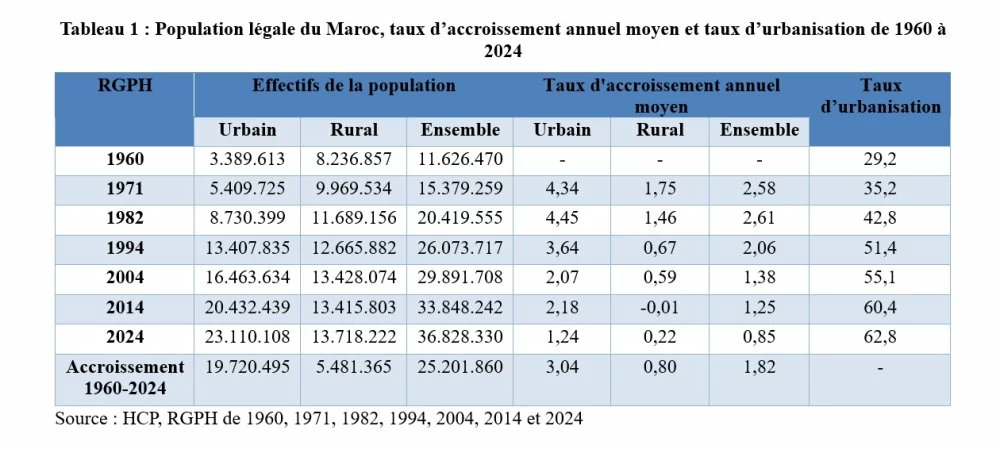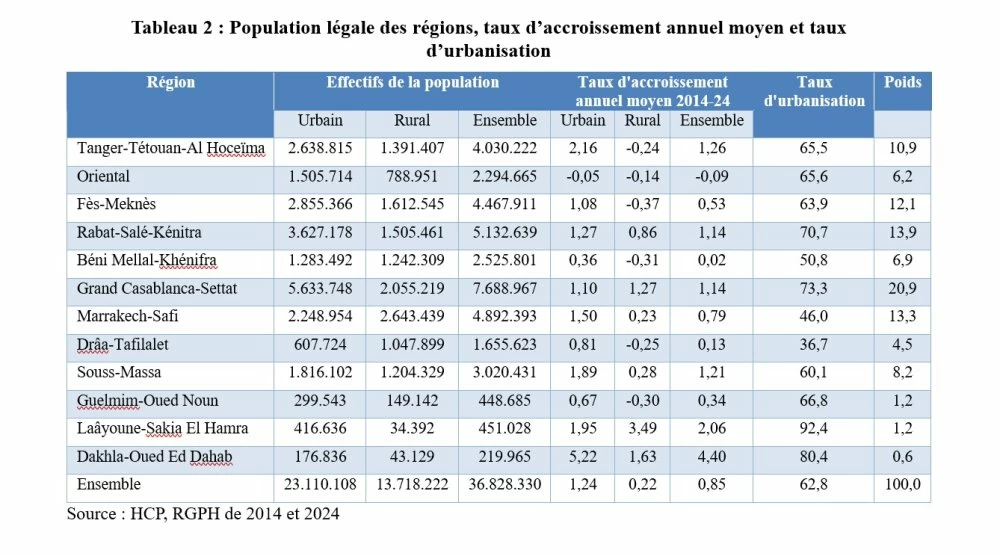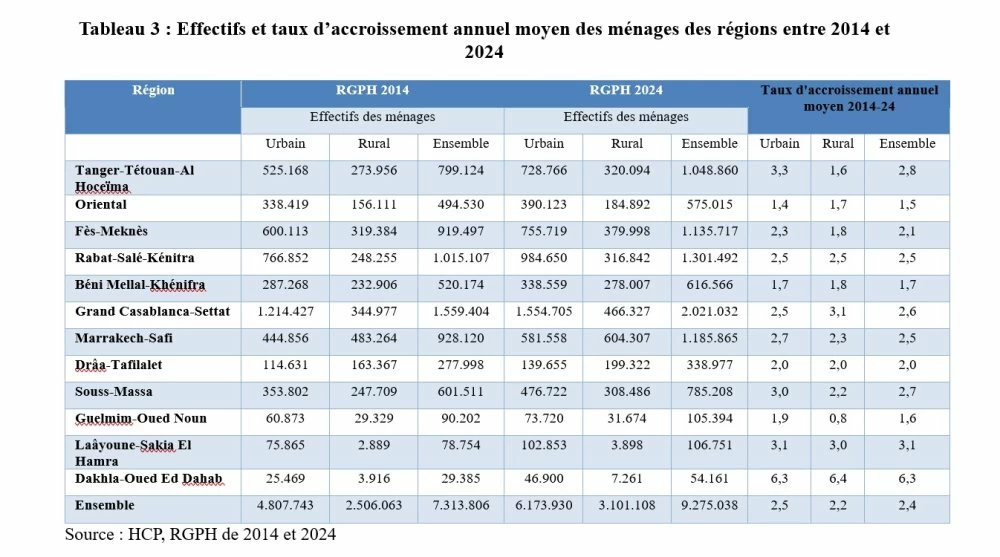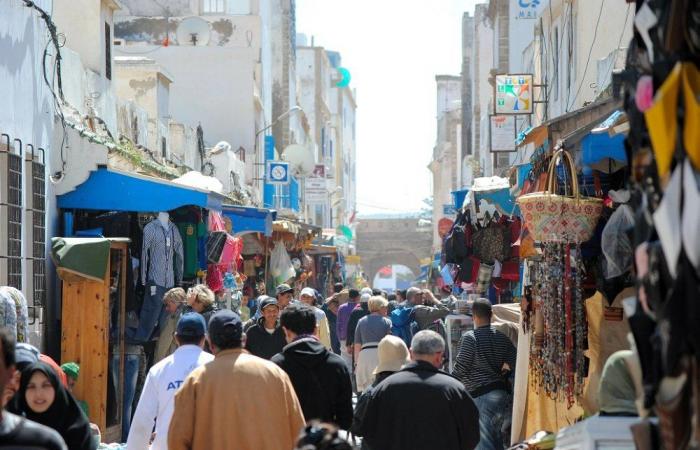The Government Council adopted Decree No. 2.24.1009 setting the legal population of Morocco distributed by regions, provinces, prefectures and municipalities according to the results of the general population and housing census of 2024 (RGPH 2024). Below is an initial analysis of the evolution of the population and households and the detailed results at the levels of the different local authorities.
According to the results of the RGPH 2024the legal population of the Kingdom reached 36,828,330 inhabitants on September 1, 2024, including 36,680,178 Moroccans and 148,152 foreigners. Compared to the census of 2014, the workforce of the population recorded an absolute increase of 2,980,088 inhabitants, i.e. an average annual growth rate of 0.85% during this period, compared to 1.25% between 2004 and 2014. The number of foreigners residing in the Kingdom has increased by 61,946 between 2014 and 2024, an annual increase of 5.6%.
In urban areas, the population reached 23,110,108 inhabitants, with an increase of 2,677,669 between 2014 and 2024, an average annual growth rate of 1.24%. In rural areas, the population reached 13,718,222 inhabitants, an increase of 302,419 compared to the 2014 census and an average annual growth rate of 0.22%.
Since 1960, the population of Morocco has more than tripled and thus strengthened by more than 25 million inhabitants in 2024, although the demographic growth observed throughout this period is in continuous decline. The average growth rate thus increased from 2.6% between 1960 and 1982 to 1.25% between 2004 and 2014 and reached 0.85% between 2014 and 2024.
This demographic dynamics is carried mainly by the urban environment. The urban population which amounted to approximately 3.4 million in 1960 increased to 23.1 million inhabitants in 2024, i.e. 19.7 million more than in 1960 and an increase at the rate of 3.04% per year. In rural areas, the population increased from 8.2 million to 13.7 million, with an average annual growth rate of 0.8% during the same period.

Five regions bring together more than 70% of the national population
Five regions are home to 71.2% of the national population. There Casablanca-Settat region comes first with 7 million and 689 thousand inhabitants and a weight of 20.9%, followed by Rabat-Salé-Kenitra region with 5 million and 133 thousand inhabitants, then the Marrakech-Safi region with 4 million and 892 thousand inhabitants, the Fez-Meknes region with 4 million and 468 thousand inhabitants, and the Tangier-Tétouan-Al Hoceima region with 4 million and 30 thousand inhabitants. The rest of the population is distributed among the other regions of the Kingdom, ranging from 3 million and 20 thousand inhabitants in the Souss-Massa region to 220 thousand inhabitants in the Dakhla-Oued Eddahab region.
The demographic dynamics observed between 2014 and 2024 are mainly driven by the regions of the axis Casablanca-Settat, Rabat-Salé-Kenitra and Tangier-Tetouan-Al Hoceimaon the one hand, and by the regions of Marrakech-Safi and Souss-Massa, on the other hand. The contribution of these regions to the overall growth in the population between 2014 and 2024 is 86.2%, with demographic growth rates varying between 0.79% in the Marrakech-Safi region and 1.26%. % in the Tangier-Tétouan-Al Hoceïma region.
Urbanization continues to grow with marked regional disparities
The urbanization rate reached 62.8% in 2024 compared to 60.4% in 2014. This rate is higher in the regions of Laayoune-Sakia El Hamra (92,4%), Dakhla-Oued Ed-Dahab (80,4%), Casablanca-Settat (73,3%) et Rabat-Salé-Kenitra (70.7%). The lowest rates are recorded in the regions of Marrakech Safi (46.0%) and Drâa-Tafilalet (36.7%).

Seven large cities are home to nearly 40% of the urban population
Seven large cities concentrate 37.8% of the Kingdom’s urban population, distributed respectively with 3 million and 236 thousand inhabitants. Casablancafollowed by Tanger with a million and 275 thousand, Fez with one million and 183 thousand, Marrakech with a million and 15 thousand, Dirty with 945 thousand, Meknes with 562 thousand and Rabat with 516 thousand.
Increase in the number of households with a reduction in their average size
The number of households in Morocco amounts to 9,275,038, distributed between 6,173,930 households in urban areas and 3,101,108 in rural areas. Since 2014, this figure has increased by 1,961,232, an average annual rate of 2.4%. In urban areas, the increase is 1,366,187 households (2.5% per year) and in rural areas, 595,045 (2.2% per year).
Thus, the average size of households decreased, from 4.6 to 3.9 people between 2014 and 2024 nationally, from 4.2 to 3.7 people in urban areas, and from 5.3 to 4 .4 in rural areas.







